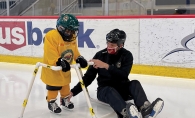While attending Washington University in St. Louis, Rachel Mairose was involved with animal rescues. She wanted to continue that involvement when she returned to her hometown of Edina after graduation. So a few years later, in 2009, she decided to start her own pet rescue organization. “I always joke that the hormones made me do it. I felt like I was Superwoman and I could do anything,” Mairose says.
With a little research, and help from friends and family, Secondhand Hounds was born and it worked. “I think the big thing is, I’m a people person as much as I am a dog person or an animal person,” she says.
Not only did people respond well to Mairose’s business model, but her business grew. She’d initially planned to keep it a small organization, with no more than 20 dogs at a time. But in its first year, Secondhand Hounds blew past 20 rescued dogs to 40. In its second year, the organization had 80 animals at a time and 100 in its third year. Currently, Secondhand Hounds handles 300-plus animals at any given time, and has rescued more than 7,300 animals since its launch.
According to Mairose, the mission is two-fold: Rescuing animals from bad situations, then placing those animals in responsible, loving “forever homes.”
The rescue operation takes in dogs from around Minnesota as well as from out of state. Minnesota animals typically go immediately from a shelter to a foster home. “We go to the shelters, take pictures and post them on our site,” Mairose says, and when a foster owner spots the animal online and volunteers to be its foster family, the animal leaves the shelter to stay with its foster family. Out of state dogs usually go to temporary foster homes in their home state before a foster family in Minnesota is found. Fostering is meant to be a shorter-term obligation, typically a month or two. Puppies are likely to be adopted within a week, but older animals or animals with behavioral problems typically stay longer in foster homes.
Those who wish to foster or adopt a pet must complete an extensive application to make sure the adopter/foster is fit to care for an animal and understands the expenses and responsibilities involved. Volunteers then visit potential foster/adoptive homes to check them out and ensure the homes are animal-friendly. If all is approved, it’s just a matter of falling in love with an animal. Fosters can choose which pets to foster, and they provide approval of a family that wants to adopt. Fosters get the first opportunity to adopt an animal they’re fostering—what Mairose fondly calls a “foster fail.” It basically means a foster becomes attached and can’t give up a dog they’re fostering, so they end up adopting it. “I’ve foster-failed twice,” says Mairose.
While the name of the organization is dog-centric, as is Mairose, she says they rescue all kinds of animals. “I came out of the gates thinking just dogs,” she says, but “when you have committed fosters who will save an animal, why not?” Everything from dogs, cats, bunnies, ferrets, chinchillas, birds, iguanas and fish have been through the system. Mairose and her family have even fostered a pig. “My daughter thought it was the coolest thing on the planet,” she says. “His name was Kevin Bacon.”
Mairose says one of the best parts of working at Secondhand Hounds is the range of volunteers– all brought together by their passion to save animals.









